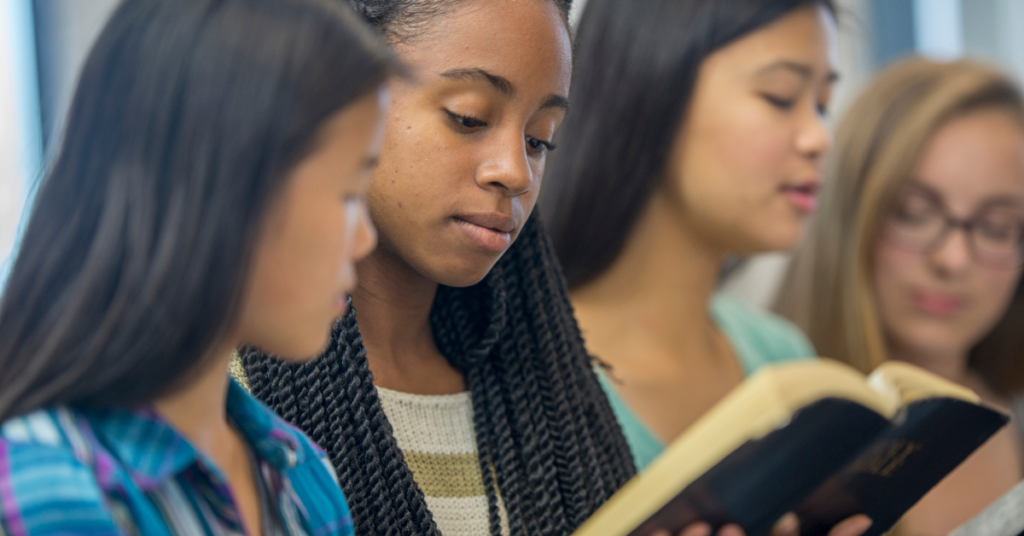Written by Angela M. Mucci-Guido, Ph.D., director, Center of Catholic School Excellence and lecturer, Mount St. Mary’s University School of Education, mucci@msmary.edu
The Catechism of the Catholic Church (1994) tells us that prayer unites us with Christ through the Holy Spirit. Essentially, when in prayer, an individual is in “communion with one and the same Father in one and the same Holy Spirit” (Catechism of the Catholic Church, 1994, p. 2790). We also learn when the Lord’s Prayer is said, “the ‘our’ at the beginning of the Lord’s Prayer, like the ‘us’ of the last four petitions, excludes no one” (Catechism of the Catholic Church, 1994, p. 2792). This call to prayer unites us with one another as we are united to and with Christ through the Holy Spirit.
One of the unique and special opportunities afforded to teachers in Catholic schools is the chance to pray openly with students. As part of a larger study (Mucci, 2011), seven secondary level Catholic school teachers were interviewed about their teaching experiences. While not the focus of the study, powerfully, teachers explained “sharing the faith” and helping “kids grow in their relationship with Christ and in their faith” by being able to “pray with [the kids]” was an overwhelmingly positive aspect of teaching in a Catholic school (Mucci, 2011).
Prayer is an integral part of the Catholic school culture (Mayotte, 2010), where “teachers and pupils experience together what it means to live a life of prayer” (United States Conference of Catholic Bishops, 1972, para. 107). The Second Vatican Council charged Catholic schools to provide students with instruction in faith and morals, which included public worship and opportunities for prayer (Denig & Dosen, 2009). The incorporation of prayer not only provides students with instruction in faith and morals but helps shape the identity and atmosphere of the school (McGrath, 2012). This is important for any Catholic school since those entering a Catholic school should have “the impression of entering a new environment, one illumined by the light of faith, and having its own unique characteristics…an environment permeated with the Gospel spirit of love and freedom” (Congregation for Catholic Education, 1988, n. 25).
In a Catholic school, opportunities for prayer can be integrated during the school day (Mayotte, 2010) whether it be through community prayer at the beginning of the school day (Jasmine & Kim, 2011), the Holy Mass, or beginning each class with a prayer (McGrath, 2012). Among the seven secondary Catholic school teachers interviewed, prayer was an important part of each class session with their students (Mucci, 2011). Many of the teachers shared that they began class sessions saying traditional prayers such as the Our Father or Hail Mary, while others “recite[d] a prayer from the heart” or linked the prayer to the liturgical season (e.g., Lent, Advent). Others considered unique ways of engaging students in prayer. For instance, in a British literature course, students were studying the Anglo-Saxon period. Due to the time period they were studying, the class recited Caedmon’s hymn. When the class moved to another era, they would recite prayers written during that time period (Mucci, 2011). Another teacher recalled how he used the Prayer of St. Francis sang by Sarah McLachlan every morning during his prayer time (Mucci, 2011). While repetitive, it became a memorable experience for the students. Yet another teacher shared that her class said traditional prayers such as the Our Father during prayer time while also being open to situations that arose where “prayer requests were brought up.” In some cases, these prayer requests consisted of “just an informal prayer praying specifically for the student or for the surgery or whatever” (Mucci, 2011). In each of these examples, prayer allowed the teacher and students to be united while being immersed into an experience rooted in Catholic tradition and connected to their academic subjects and personal lives.
For students to feel connected to the prayers recited, the prayers should be meaningful and personal (Jasmine & Kim, 2011). Therefore, it is important to consider how student “voices” are captured in prayers selected. Do students have opportunities to provide input? Are there some student “voices” in the school or classroom captured more than others? These questions help ensure students can fully participate in this experience, especially considering how Catholic schools are becoming more diverse in student demographics of race, ethnicity, religious background and documented special needs (National Catholic Educational Association, 2023). Therefore, ensuring differences do not separate or exclude any person is vital for prayer to unite and be meaningful.
In Matthew we read, “For where two or three are gathered together in my name, there I am in the midst of them” (Mt. 18:20). Prayer helps a Catholic school become a community (Denig & Dosen, 2009). It allows Catholic schools to be distinctive in mission and curriculum. It also immerses teachers and students in traditions and experiences rooted in our Catholic faith. In essence, prayer is a powerful reminder of our Catholic teachings and values. Truly, one of the unique and special opportunities afforded teachers in Catholic schools is the chance to pray openly with students.
Let’s revisit the teacher who used the Prayer of St. Francis sang by Sarah McLachlan every morning during prayer time. He shared when posting the song to Facebook, he received comments from alumni who had been in his classes. A reoccurring theme among the Facebook comments was the impact this prayer had on them and how it brought back memories from his class (Mucci, 2011). This illustrates how prayer goes beyond recitation but can touch the heart of an individual. When this happens, the impact is profound and lasting.
This is the call of prayer in a Catholic school. So, the question becomes how can prayer be incorporated in your classroom or school to unite, deepen and ground the identity and atmosphere of your classroom or school?
